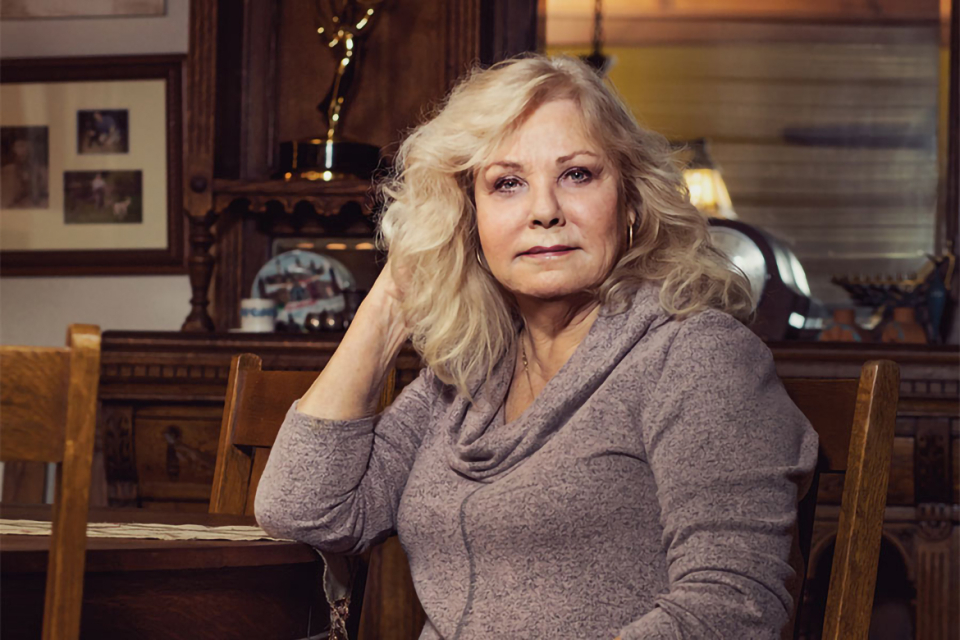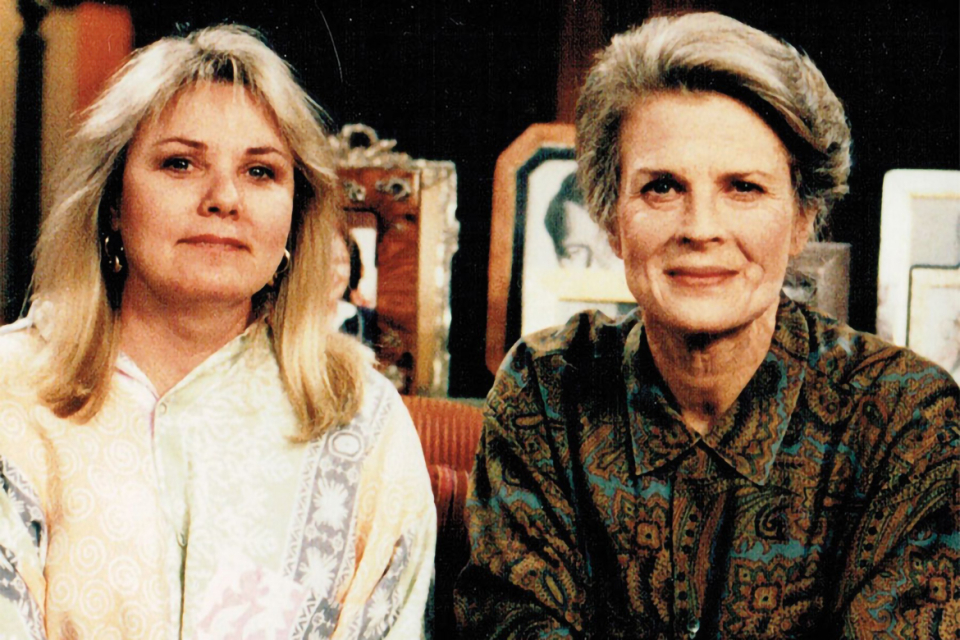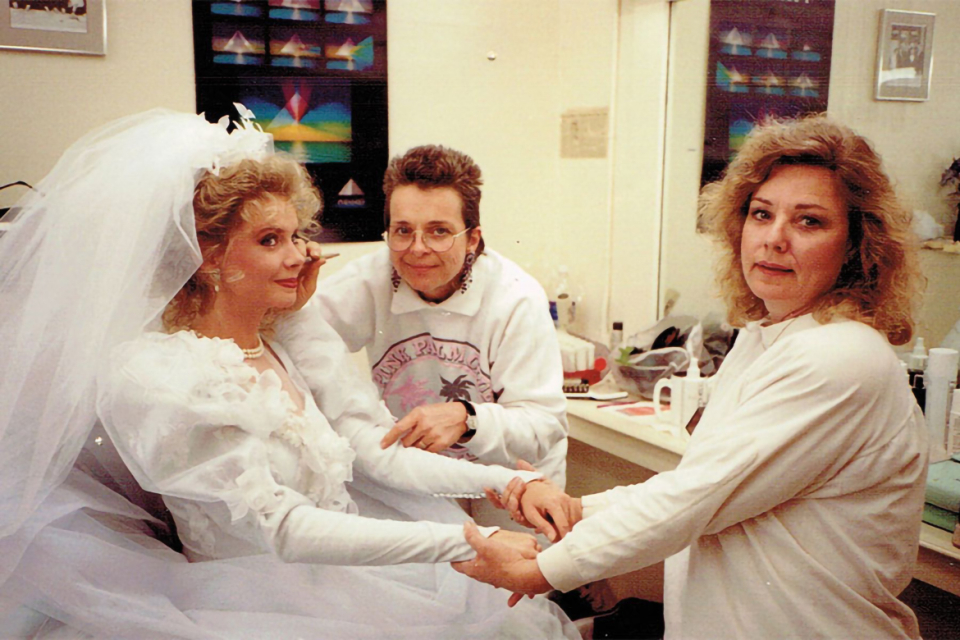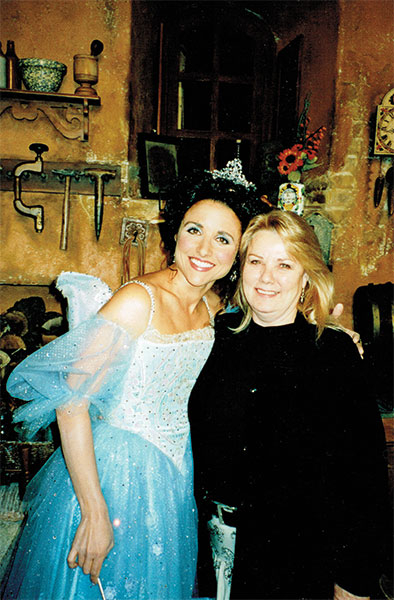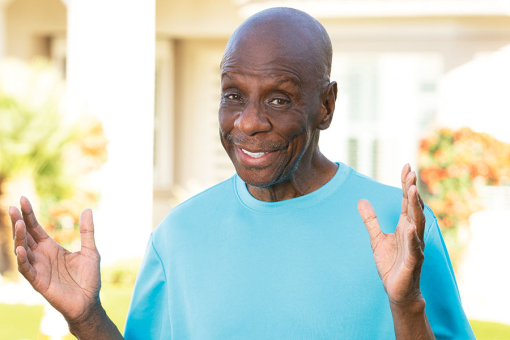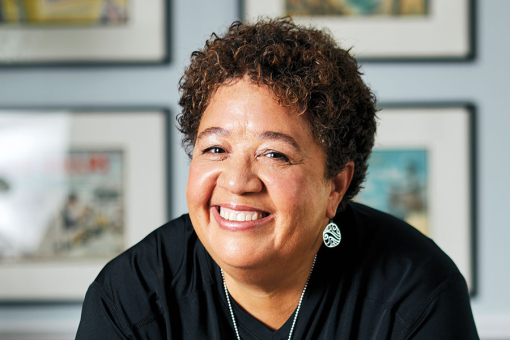Any look back at the styles of the 1980s affirms an ardent embrace of big hair. The artist behind such colossal coifs, Judy Crown, created the 'dos for Cybill Shepherd in Moonlighting and Candice Nergen in Murphy Brown, among many other stars.
"If something goes wrong, tease it," Crown quips. And though she got her start with '60s looks, she has never been wedded to one era. "Whatever period I'm doing," she says, "I love to get it right."
A native of Washington, D.C., Crown launched her career there; in the 1970s, she moved to L.A., where she began doing hair for television. Over the decades, she compiled credits as a hairstylist, key hairstylist and hair department head on hit series such as Designing Women, Seinfeld and CSI.
Thinking back, she reflects that a successful project is one where she felt valued, and she felt that most strongly on Murphy Brown, working with creator–executive producer Diane English. "That was one of the least stressful environments that I've worked in, in the 30 years I've been in the business," she says.
"They paid me well and appreciated me. And that's all you need. Even if they don't pay you well, you need to be appreciated."
Recognition of her artistry has led Crown to the Emmy stage. She has been nominated for seven Emmy Awards and won two: in 1988 for Designing Women and in 1999 for the telefilm Houdini.
Crown was interviewed in April 2016 by Adrienne Faillace for The Interviews: An Oral History of Television, a program of the Television Academy Foundation. The following is an edited excerpt of their conversation. The entire interview can be seen at TelevisionAcademy.com/Interviews.
Q: How did you get your start in the industry?
A: I worked at the AFL-CIO headquarters in Washington, D.C. as a secretary, and I was able to go to beauty school every night after work. I became a hairdresser and went to London to get extra training at Vidal Sassoon's.
It was a wonderful experience. I came back and managed a salon for a few years and worked at different salons. Then it dawned on me that I could be a hairdresser in the film business.
My friends Bill and Taffy Danoff were musicians, and they became the Starland Vocal Band. I became their hairstylist. They got a record contract, and we toured with John Denver; then they got a little summer show, The Starland Vocal Band Show.
That was my first job in show business. It was a very small production. It was mostly me doing their hair, getting them ready and sending them up onstage. I was thrilled to be with my friends, who were having their dream come true.
Q: In 1983, you were a hairstylist on the TV movie The Day After.
A: It was supposed to be a four-episode miniseries, but it ended up getting cut back to a TV movie. There were lots of wonderful actors — Jason Robards, JoBeth Williams, Steve Guttenberg — but there were only two of us hairdressers.
They would bring in extra help from time to time, but we had 1,000 extras one day who had to come through hair and makeup. They had all been victims of this bomb, and their hair had to be dirtied up. They brought one hairdresser to help us.
We started out at three or four in the morning getting these people ready, and we got them done by one in the afternoon. Along the way, the director decided he wanted us to shave people's heads in spots so that you could see that the hair had fallen out and that they were dying of radiation burns.
Mike Westmore was the makeup department head, and he was very collaborative. We had this gel that we had to put in people's hair, then Michael would paint it to look like burns.
That was my first experience of doing what essentially is a prosthetic. Makeup artists usually do it, but we worked out how we could do it. It was a collaborative, creative effort that we had never done before. It was pretty exciting.
Q: In 1985, you started on Moonlighting with the famous black-and-white episode "The Dream Sequence Always Rings Twice."
A: Cybill Shepherd really lends herself well to a '40s look. I got along with her really well; I really enjoyed her. My dear friend Norman Leavitt was the makeup artist. That episode was very exciting. Cybill sang in that show, and it was a really good experience. I was very proud of the work.
Q: Did you do research into '40s styles for that look?
A: I didn't, because hairstyles of different periods have always been of interest to me, even when I worked in salons. That's one of the reasons I wanted to work in the TV industry, because I could do hairstyles not just of today, but as far back as you can figure out people had hair. So I was very familiar with '20s, '30s and '40s looks before I did that show.
Q: You started working on Designing Women at its debut, in 1986. Did you help craft the initial looks for the stars?
A: Very much so. I ended up doing hair for three of the four women most of the time. At first, I was doing Dixie Carter, Jean Smart and Delta Burke, then I ended up with Jean and Annie Potts.
Q: How long would the ladies typically take in hair?
A: We would go to work about two in the afternoon. They would rehearse for a while, then we would do hair and have dinner, then we'd touch up and start the show. I think they took longer in makeup than they did in hair. Tommy Cole and Claude Thompson were the makeup artists and they were both great.
Q: This was the mid-'80s, so hair tended to be big. What products were you using then?
A: Mostly electric rollers, and a lot of setting lotion and spray.
Q: Would you follow the trends of the day?
A: We did, but these were Southern women, so they wore their hair a little bit bigger than average.
Q: What's your approach to working with actors?
A: In the beginning, I always ask them how they like to wear their hair, how they see their character, what they're comfortable with and how they would like to wear their hair for this particular episode or series. Sometimes we try a few different looks and sometimes we find the best hairstyle right off the bat.
Q: Do you consult with wardrobe?
A: Hair does have to coincide with wardrobe, so it's good to talk to the costume designer and see the wardrobe.
Also, during a series or even an episode, people may change their hair. You have to keep continuity, because you may shoot scenes out of order. You have to know what hairstyle the character had at any given point in the script, so that you know what to do in that particular scene.
Q: And you'd largely be tracking continuity with photos?
A: With photos and script notes.
Q: You were also involved with the pilot of Murphy Brown ….
A: I got that job because I had done My Sister Sam with Diane English, who is an absolute genius, a real mensch and somebody I really loved working for. Part of the reason was that she appreciated what I did; she didn't belittle it. She didn't think I could take a Magic Marker and instantly color someone's hair, like some other producers have.
She knew that it was a process and that I had a certain skill. When she wanted an actor's hair to look a certain way, she would come into the makeup room and sit down and watch me perform. She appreciated the process, and that was so gratifying.
We did one episode in which Murphy loses her hair because she has breast cancer and has to have chemotherapy. I still have her wig.
The makeup artist put a bald cap on her [Candice Bergen] and then I put on this very skimpy, fine wig that had no blonde streaks. It wasn't even the same color as her hair. After that, she had short hair, and we watched her character's hair grow out over time. Diane loved watching us create that, and I loved doing it — it was one of the really creative things I got to do on the show.
Q: Did Murphy have different looks — for home, the office and on air?
A: She did have some hairstyles that were different at home. When she was having her baby, her hair was everywhere — I loved it when she did things like that. And one time, when Murphy was on air but kept falling asleep, they made me an extra, on screen. I was trying to touch up her hair, be an extra and a hairstylist — it was fun.
Q: Were you ever working on multiple shows at once?
A: At one point I was doing Murphy Brown, Designing Women and Dear John all at the same time.
Q: How?
A: It wasn't easy. I was doing Dear John on Tuesdays — they would shoot on one day, generally, but some shows would shoot on two days. Murphy Brown and Designing Women were on the Warner Bros. lot. Murphy Brown would shoot on Friday and Designing Women on Thursday.
I bought a bike so that I could run back and forth on Thursdays in case Designing Women and Murphy Brown happened to be shooting on those days. Sometimes Murphy Brown would pre-shoot on Thursday and I would have to run back and forth between the stages. It was crazy.
But Murphy Brown was one of the least stressful environments that I've worked in, in all of the 30 years I've been in the business. They paid me well and appreciated me. And that's all you need. Even if they don't pay you well, you need to be appreciated.
That's why I love Jason Alexander. He appreciates me and trusts me when I create his hairpieces for his different characters.
Q: So let's talk about Seinfeld, which you started on in 1993.
A: Yes. The hairdresser left and they called me. When I started, Julia [Louis-Dreyfus] was wearing a funny hairstyle, and I suggested to her that we do something else. So we did something new and we got along really well. Then there was this news blurb that Julia Louis-Dreyfus had been voted best hair in television by TV Guide.
The Oprah Winfrey Show called me, and I went on it. I was in the first row in the audience, and they were up on the dais talking about Julia and Seinfeld. When they asked me about Jason's hair, they said, "It takes longer to do Jason's hair than anybody's." I went, "No, it doesn't!"
Jason would always say it took longer to do his hair than anybody's, which wasn't true. But that was a little bit of publicity, and we had a good time. We worked really hard. That was a sitcom that worked almost every day. We worked at least three days a week, sometimes four. You couldn't really do another show if you had Seinfeld.
And Jason turned out to be just one of the dearest people I've ever known, and that show was really fun because they liked to do crazy things. One time I had to style a mannequin that looked just like Julia.
Q: You changed Julia's style when you came on. What did you do?
A: I took that big roll out and curled her hair and let it fall in her natural pattern. We never went back to that roll in the front. It made her look frumpy, and she's so beautiful.
What amazed me about the cast is that they got script changes all the time. We'd be in that little makeup room doing hair and the script supervisor or somebody would come in and say, "We've got some new pages," and they could just memorize it. Every one of them had a photographic memory, I think. Except for Michael Richards. He'd pace back and forth trying to remember his lines.
Q: Did his hair naturally have that volume?
A: Yeah. He would just pull it up a little bit, but it was just about that length. It was a nice part of his look and he had very good physical comedy.
Q: So tell us about styling Jason Alexander. How long would he actually take in the chair?
A: 10, 15 minutes. I knew that he didn't like not having hair, but he also told me that his career took off when he started losing his hair. He related those two events, though they may not have had anything to do with each other.
When I first started on Seinfeld, he had a little bald spot, and in the back of the bald spot there was a little divot. So I took a little eye shadow and colored around the hair so it blended in. I did it across the top, too, and he really liked it.
But he is also adorable when he has a hairpiece on. For the movie Dunston Checks In, we did a really nice hairpiece for him with a receding hairline. He's got a very handsome face. I've done a few shows with him with hairpieces. Bye Bye Birdie was one of them.
Q: I think he had a toupée in an episode of Seinfeld, too….
A: Yes, he did. They wanted George to have a toupée that was really ugly. So I went to a wig place that I know. In their backroom, they sell these things for five dollars — old toupées that other people have used that nobody wants anymore. I bought them all and brought them to the show, and I tried to find the worst ones.
Every single one I put on him made him look so cute! When you see him on television, you can't see how terrible a toupée looks unless it's really, really bad. We had a hard time finding one that looked bad enough to be funny.
Q: In 2007 you decided to retire. Why were you ready to leave the business?
A: After working for 30 years for 16, 17, 18 hours a day, I said, "I'm done. I did it." I've gone back to work a few days here and there with friends, but I love being retired. And I love that I accomplished it all.
Q: Do you have a favorite type of hairstyle to do?
A: I really love '40s hairstyles. And I like '60s hairstyles, because that's how I started. My fallback is, if something goes wrong, tease it. The '60s hairstyles are like falling out of bed for me. My challenges are the '20s, '30s and '40s. I like those, and I like a lot of periods in the 1800s, too, because the women's styles were long, with lots of curls and waves.
Whatever period I'm doing, I love to get it right.
Q: How has hairstyling for television changed since you started in the business?
A: Well, I'm not sure that it's improved. British television has always done it right. The British have always been meticulous at getting the period right. I don't have to hear sound; I don't have to know what the show is. If you show me a clip, I will tell you if it's British. They really work at it, and they train their people a lot harder than Americans.
When you go to beauty school in the U.S., you don't learn about hair from different periods. There's no apprenticeship program here. I would like to see us be more meticulous.
Q: What do you enjoy most about hairstyling?
A: The creativity. It's like painting, drawing or sculpting. It's shaping things. It's working with my hands. I like to make things. And I like the interpersonal communication, as well. I like making someone look pretty, or cool, or whatever the character calls for.
This article originally appeared in emmy magazine, issue No. 3, 2019

